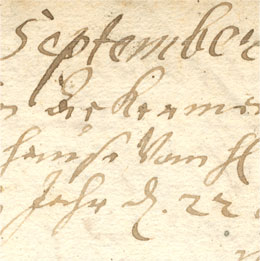Which pulpit did Ackermann redesign in 1707 and who had originally fashioned it?
In 1707, Christian Ackermann redesigned the church pulpit of the Swedish congregation that operated in the former Church of St. Michael (nowadays Tallinn’s Cathedral of the Transformation of our Lord on Suur-Kloostri Street), which was at the disposal of female Cistercians. Lüdert Heissmann fashioned the pulpit in 1632.
The pulpit had a corpus with five sides and a staircase attached to its southern side starting from the side facing the altar. Figures carved in high relief – Salvator Mundi, St. John the Apostle and Evangelist, St. James the Apostle (?), and another two figures, which have not survived – evidently decorated the pulpit’s corpus. Statues of the apostles were apparently on the pulpit’s stair balustrade, which ended with a portal adorned with a gable. It is no longer possible to say exactly what the architectonics of the corpus, stair balustrade, and portal of the pulpit of Heissmann’s time were like, and what supported the pulpit. Sculptures from some earlier carving were in turn used on the sounding board of the pulpit associated with Heissmann’s name, and this is noteworthy.
Hence it can be said that when Ackermann undertook the renovation of the pulpit of the Swedish St. Michael’s Church in 1707, he had to take the work of previous master(s) into consideration. At the same time, the question remains whether the pulpit’s peculiar iconographic programme (in the context of ecclesiastical art of the end of the 17 th century and the start of the 18 th century) was put together in Ackermann’s time or during some later redesign of the pulpit.
Which parts of the pulpit originate from Ackerman and his assistants?
Excluding the ornamentation of its cornice – a gable adorned with three sculptures – the corpus, stair balustrade, and door portal of the Swedish St. Michael’s Church pulpit originate from Ackermann’s workshop. Just like Ackermann’s earlier pulpits, twisted colonnettes with Corinthian capitals and putto corbels articulate the sides of the corpus. Much like the Karuse and Juuru pulpits, carved figures are situated between the twisted colonnettes. Nameplates are situated beneath them. Just as with the pulpit in Tallinn’s Cathedral, pictures of the apostles and their nameplates decorate the stair balustrade panels. The panelled door at the end of the staircase, which is framed by lisenes with Corinthian capitals, is also from Ackermann’s time. Similarly to several other pulpits by Ackermann, the figure of Moses supports the Swedish St. Michael’s Church pulpit. The naturalistic garland consisting of various plants and blossoms that adorns one side of the pulpit’s corpus was also carved by Ackermann.
What was the pulpit’s original polychromy like?
Thanks to the account book of the Swedish St. Michael’s congregation, it is known that the painter Heinrich Warner (Werner) coated the pulpit that was completed in Ackermann’s workshop with laccolour, gold, and silver. The pictures of the apostles adorning the stair balustrade panels and the nameplates of all the depicted figures probably also originate from him. The figures situated on dark grey marbled backgrounds were originally polychromatic: they had flesh tone hands and feet, and faces that were painted quite naturalistically. The garments of the figures were coated using so-called lustre tones, meaning that a thin coat of red or green paint was applied to silver-plated surfaces.
When was the pulpit that was redesigned in Ackermann’s workshop set up and where was it later taken?
According to the account book of the Swedish St. Michael’s congregation, the pulpit fashioned by the sculptor Ackermann and painted by Heinrich Warner, more precisely the pulpit’s corpus and staircase, was installed in the church located on Suur-Kloostri Street in May of 1707.
After Tallinn capitulated to the Russian forces in 1710, the Swedish congregation continued to operate in the former church of the female Cistercians that had belonged to the congregation since 1630, but not for long. In 1716, Alexander Menshikov, the commander-in-chief of the Russian forces, issued an order to Tallinn’s town council to move the Swedish St. Michael’s congregation out of the church where it had hitherto operated and to hand the building over to the Russian garrison’s congregation.
Before the new almshouse building on Rüütli Street became the home of the Swedish St. Michael’s congregation, the congregation had to operate in temporary spaces and quite likely to find a place to store its moveable property. In 1726, the new almshouse building on Rüütli Street was placed at the congregation’s disposal. It was consecrated as a church in 1733.
The enigma of the door portal’s design
The question of when the gable and the statues of Salvator Mundi, St. John, and St. James that had belonged to the corpus of the former pulpit, which had been carved in Heissmann’s workshop, were added to the cornice of the door portal of the pulpit, which was reconstructed by Ackermann, has remained an enigma to this day. These three statues make the pulpit’s iconographic programme questionable – namely, there is not a single baroque pulpit or retable in Estonia where a figure bearing one and the same message (in this case Salvator Mundi) is depicted twice.
